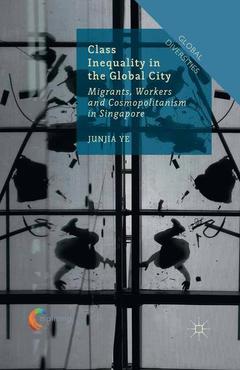Description
Class Inequality in the Global City, 1st ed. 2016
Migrants, Workers and Cosmopolitanism in Singapore
Global Diversities Series
Author: Ye J.
Language: English
Subject for Class Inequality in the Global City:
Keywords
Class; cosmopolitanism; feminist methodology; identities; labour; development; Southeast Asia; Singapore; feminism; identity; methodology; migration; Nation
Publication date: 02-2020
193 p. · 14x21.6 cm · Paperback
Publication date: 03-2016
193 p. · 14x21.6 cm · Hardback
Description
/li>Contents
/li>Biography
/li>
In striving to become cosmopolitan, global cities aim to attract highly-skilled workers while relying on a vast underbelly of low-waged, low status migrants. This book tells the story of one such city, revealing how national development produces both aspirations to be cosmopolitan and to improve one's class standing, along with limitations in achieving such aims. Through the analysis of three different groups of workers in Singapore, Ye shows that cosmopolitanism is an exclusive and aspirational construct created through global and national development strategies, transnational migration and individual senses of identity. This dialectic relationship between class and cosmopolitanism is never free from power and is constituted through material and symbolic conditions, struggles and violence. Class is also constituted through 'the self' and lies at the very heart of different constructions of personhood as they intersect with gender, race, sexuality, ethnicity and nationality.
Introduction. Globalizing work in Singapore: class, migration and divisions of labour in the city-state
1. Researching inequality in the global city
2. Situating class in Singapore: State development and labour
3. Migrating to Singapore: Bangladeshi men
4. Commuting to Singapore: Johorean Malaysians
5. Constructing cosmopolitanism in Singapore: Financial professionals
Concluding Reflections
Junjia Ye is Lecturer in Human Geography at Massey University, New Zealand. She has published writings on cultural diversity, critical cosmopolitanism, class and gender studies. Alongside extensive ethnographic research methods, she also uses techniques of film and photography to create visual narratives through her work. She was previously Postdoctoral Research Fellow at the Max Planck Institute for the Study of Religious and Ethnic Diversity, Germany.




